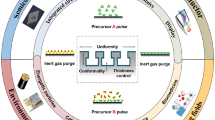Abstract:
Nucleation on top of two-dimensional islands with step edge barriers is investigated using scaling arguments. The nucleation rate is expressed in terms of three basic time scales: the time interval between deposition events, the residence time of atoms on the island, and the encounter time required for atoms forming a stable nucleus to meet. Application to the problem of second layer nucleation on growing first layer islands yields a sequence of scaling regimes with different scaling exponents relating the critical island size, at which nucleation takes place, to the diffusion and deposition rates. Second layer nucleation is fluctuation-dominated, in the sense that the typical number of atoms on the island is small compared to , when the first layer island density exponent satisfies . The upper critical nucleus size, above which the conventional mean field theory of second layer nucleation is valid, increases with decreasing dimensionality. In the related case of nucleation on top of multilayer mounds fluctuation-dominated and mean field like regimes coexist for arbitrary values of the critical nucleus size .
Similar content being viewed by others
Author information
Authors and Affiliations
Additional information
Received 4 September 2000
Rights and permissions
About this article
Cite this article
Krug, J. Scaling regimes for second layer nucleation. Eur. Phys. J. B 18, 713–719 (2000). https://doi.org/10.1007/s100510070019
Issue Date:
DOI: https://doi.org/10.1007/s100510070019




